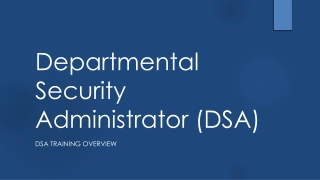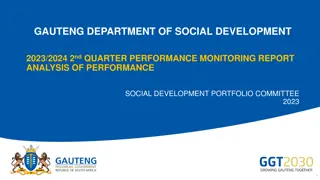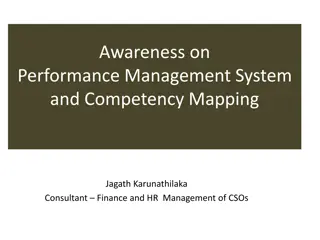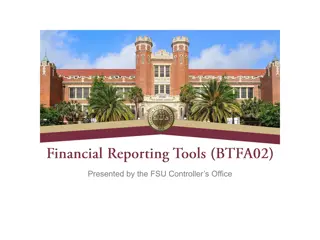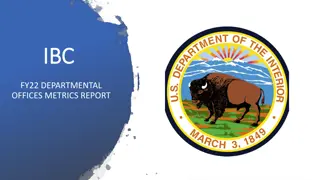Departmental Performance Review Overview
The Departmental Performance Review (PR) is a comprehensive evaluation process conducted for faculty members to assess their performance in various academic settings. It includes determining Right of First Refusal (RoFR) for sessional and LTC faculty, evaluating eligibility for contract extensions, and reviewing tenure-track appointments. The PR results are shared with the Dean, and the process involves consultations between the Department Chair and Dean. This assessment is crucial for ensuring the quality and continuity of faculty members' roles within the academic institution.
Download Presentation

Please find below an Image/Link to download the presentation.
The content on the website is provided AS IS for your information and personal use only. It may not be sold, licensed, or shared on other websites without obtaining consent from the author.If you encounter any issues during the download, it is possible that the publisher has removed the file from their server.
You are allowed to download the files provided on this website for personal or commercial use, subject to the condition that they are used lawfully. All files are the property of their respective owners.
The content on the website is provided AS IS for your information and personal use only. It may not be sold, licensed, or shared on other websites without obtaining consent from the author.
E N D
Presentation Transcript
The Departmental Performance Review (PR) November 4, 2020 Presented by: Amy McLay Paterson PRC Coordinator
The Performance Review (PR) Evaluation of performance under Article 7 is summative; the results are shared with the Dean. The Department Chair and Dean meet and consult in the first two weeks of the semester or contract and determine whose performances will be reviewed, their name(s) for summative PR are then sent to the chair of the PRC [7.1.4] 2
The Performance Review (PR) Performance reviews are conducted in the following cases [Article 7.1.3(b)]: To determine Right of First Refusal (RoFR) for sessional faculty [5.2.5.2.1] To determine RoFR for LTC faculty in the final year of the contract [5.2.4.2] mandatory To determine eligibility for extension of a Limited Term Contract under the terms of Article 5.2.4.4 mandatory Review for 3 year renewal of Tenure-Track appointment [5.2.2] mandatory Faculty member request (e.g. for tenure/promotion) Dean direct request: when request approved by the PRC after examining the factual evidence 3
PRC Meetings for Sessionals 5.2.5.2.If, at the expiration of a Faculty Member s Sessional appointment substantially the same sessional work, as determined by the department, is available within the next 12 months, the Sessional Faculty Member shall be given a probationary right of first refusal for this work. 5.2.5.2.1 A Sessional Faculty Member must have a satisfactory (has met the required standard) evaluation completed as per Article 7 following their first sessional appointment and prior to the end of the probationary right of first refusal appointment to earn right of first refusal for substantially the same sessional work in the future. After completing substantially the same work over two (2) work terms with no evaluation being performed, the Faculty Member shall be given the right of first refusal for this work. 4
PRC Meetings for Sessionals, ROFR is established [5.2.5.2 ] When sessional faculty member undergoes a successful performance review after initial appointment on a course or work for substantially the same course (or work) in the subsequent academic year if this work is available. If sessional faculty meets posted qualifications [5.2.5.2.4]. If NO Performance Review (PR) is done for a sessional faculty: Probationary ROFR after teaching course once Automatic ROFR after teaching the course for two semesters Sessional Faculty with RoFR who are successful applicants for Limited Term Contracts, maintain RoFR for sessional work after the completion of the LTC [5.2.5.2.3] Important to note: since the Dean meets with the Chair as per 7.1.4 the Chair has the responsibility to ensure the PRC occurs. The Chair should not forget to do a PRC nor wait for it to be automatic. 5
The Dean-Requested Performance Review Dean/Director must provide written evidence to the PRC supporting the request for a review [7.1.3(b)(iii)] The PRC meets (including TRUFA observer) to review the Dean/Director s evidence and vote on whether to proceed with the review If the request is approved, the timeline dictated in Article 7.1.5 applies The Dean/Director s evidence is not to be used as evidence in the review. The summative performance review is based on items outlined in Article 7.3.7.2 If the Dean/Director s request for a PRC is denied, the decision not to review will be communicated in writing [7.3.7.3] 6
PRC Membership In each Department, a Departmental Performance Review Committee (PRC) shall be formed consisting of: a minimum of three elected Faculty Members; one Faculty Association representative (non-voting); and the Department Chair (non-voting). Multiple genders shall be included wherever possible. At least one Faculty Member of the committee must be representative of the appointment type (ie. bipartite or tripartite) of the Faculty Member(s) being evaluated. If a representative from one of the appointment types is not available, then the committee shall choose such a representative from a cognate department.[7.3.1] The performance of a Faculty Member shall not be reviewed by anyone with a real or apparent conflict of interest [7.3.2] Normally, the elected Faculty Members shall be Tenured Faculty Members of that Department. The Department Chair shall normally act as chair of the PRC. [7.3.3] In the case of Departments having fewer than nine Tenured Faculty Members, one or more cognate Departments may be combined to form a PRC according to Article 7.3.1. In multi-Department PRCs, each Department Chair shall be a non-voting Faculty Member, who may rotate chairing the Committee. [7.3.4] 7
Electing PRC Members [7.3] TRUFA advises a formal, secret ballot election by all department faculty be held to choose three normally tenured PRC members Ideally, the PRC members terms (3 years is ideal) should be staggered to allow for mentoring and continuity Department Chair normally chairs the PRC, unless the Chair is being evaluated or is in a conflict situation PRC members should be reminded that all discussion and recommendations are to be held in confidence 8
PRC Procedures Once the PRC committee is formed, the chair must identify departmental faculty for whom an evaluation is mandatory and send them the Notice of Summative Performance Review [7.1.5] The Notice of Summative Performance Review must be sent no later than the third week of the semester in which the review is to begin TRUFA has developed a template letter for this purpose, available in the TRUFA website, see: http://trufa.ca/performance-reviews/ 9
Summative PR based on [7.3.7.2]: APAR, as per Article 7.2 For Faculty Members with teaching responsibilities: A teaching dossier as outlined in Article 6 Appendix 1 Classroom visitation and assessment by colleague, one (1) per each year of contact under review Instructional Support/Professional Role Responsibilities A statement of professional role philosophy, as well as a statement of goals and objectives A description of professional development in the professional role area Evaluation of Faculty Member s performance in the professional role, where applicable, for the academic year(s) under review, as evidenced by instruments and procedures developed based upon departmental requirements; and Peer assessment by colleague(s), one per year of contract under review Service, where applicable Scholarship (tripartite) Other relevant evidence (see Article 6.11) 10
APAR An APAR is a formative tool for a Faculty Member to report on their current academic year s activities, goals and outcomes as they relate to the Faculty Member s research/scholarship, teaching/professional role, service, and professional development, as well as identify specific goals for the upcoming academic year All LTC, Tenure-Track, Tenured and University Instructor (UI) faculty members submit APARs to Chair and Dean no later than June 30 each year [7.2.2] Completed in standardized forms [7.2.3] Dean and Chair respond to APAR no later than October 31st [7.2.4] 11
Teaching Dossiers for PR Follows Article 6 Appendix 1 Teaching dossiers will differ in size and complexity, depending on the Faculty Member s workload and career stage. Since Sessional and University Instructor Faculty Members are reviewed on a course by course basis, their teaching dossiers will reflect only the course on which they are being reviewed Tenure-Track and LTC faculty members undergoing a performance review do not need to meet the requirements for Tenure and Promotion in that area, but their progress towards these goals should reflect their appointment and career stage 12
Student Questionnaires Administrated by TRU s Integrated Planning and Effectiveness (IPE) every course, every semester During the last 3 weeks of instruction for fall and winter semesters, and the last week of instruction of any summer session course TRUFA recommends that faculty get a colleague or staff member to administer course evaluations for them Student confidentiality: Reports with fewer than 5 results are not distributed (consistent with the practice of BCStats and the BC Statistics Act) 13
Student Questionnaires in the PR Student course evaluations may be used as evidence of students classroom experience and for the purposes of the Faculty Member demonstrating reflective scholarly practice, but they may not be used as evidence of teaching effectiveness [7.3.7.2(b)(i)] For the Faculty Members who do not have at minimum 3 course evaluations as per Article 6 Appendix 1(c)(iv), they will be required to submit an analysis of all course evaluations for the period under review [7.3.7.2(b)(ii) Basically, student course evaluations for Teaching Faculty Members will still be submitted, but they can no longer be used in the same way. 14
PRC Meetings Once the student survey results and colleague classroom visitation assessments have been submitted to the PRC chair, the chair shall schedule the first committee meeting The meeting cannot take place without the TRUFA observer in attendance Contact the TRUFA Performance Review Coordinator to schedule a TRUFA observer PRC chairs should ensure that the TRUFA observer is included in meeting schedule planning 15
Role of TRUFA Observer Ensures that PRC and its processes follow the Collective Agreement Member is evaluated in a fair, objective, and consistent manner and process is completed in a timely manner Completion includes Dean s responsibilities under 7.3.7.8 and 7.3.7.9 In consultation with Table Officers: Advisor on specifics of process, e.g. roles, evidence, members rights 16
PRC Meetings The PRC assessment and recommendation are guided by a) Article 6.11.5 guidelines for teaching, professional role, service, and scholarship and Article 6 Appendix I (if applicable) b) Department-determined standards for satisfactory performance in teaching, professional role, service (if applicable), and scholarship (if applicable) 17
PRC Meetings The PRC should give consideration to the following [7.3.7.4]: (a) Individual consideration of each Member s case (b) Comparative consideration of the assessment of all Members in the Department(s) or discipline area (c) The Member s assigned workload in the Department/Discipline (d) The appropriateness of the facilities and resources available for the Member s teaching and scholarship; and (e) Normally increasing expectations of performance as a Member progresses from rank to rank 18
PRC Meetings The member being evaluated is given the opportunity to meet with the PRC before the review is completed [7.3.7.5] The member has the choice to accept the invitation or not Invitation is to clarify or supplement information if the member under evaluation thinks that it is needed (NOT to grill the faculty member) After member meets with PRC they leave and committee considers its recommendations in camera If the Member accepts the invitation, set aside 10-15 minutes at the beginning of the allotted meeting time 19
PRC Recommendations After the review is completed, the PRC shall recommend to the Dean one of the following: The Member s performance has met the required standard a) or The Member s performance has not met the required standard a) The PRC writes a Review Report to the Dean with its recommendation using a standard template provided by TRUFA, see http://trufa.ca/performance-reviews/ Copy the TRUFA observer 20
Performance Review Report to the Dean should include: Name, rank, position and department of Faculty member Names of all faculty members of PRC at meeting of final review List of evidence used in summative evaluation Standards to be met Statement of faculty member under review being invited to attend and whether attended or declined Recommendation: HAS MET or HAS NOT MET required standards List of reasons on the basis of factual evidence from the materials reviewed In the case of a successful review, add positive attributes noted Only in the case of an unsatisfactory evaluation, add recommendations for improvement 21
Dept. Elects PRC Chair & Dean Identify Members Needing PRC (during first two weeks of semester) Notice of PR Sent to Member (no later than third week of semester) PRC Schedules Peer Class Visitation (mid semester; i.e., week 8 - 10) Chair Contacts PRC & TRUFA Rep to Schedule PR Meeting PRC Invites Member to Meet with Committee PRC Meets, Completes PR, Sends Review Report to Dean/Director with Recommendations 22
Questions? If you have questions or need clarification on issues related to Performance Reviews, please contact: Amy McLay Paterson, TRUFA PRC Coordinator or Lloyd Bennett, TRUFA Vice-President, Salary & Working Conditions 23

 undefined
undefined





